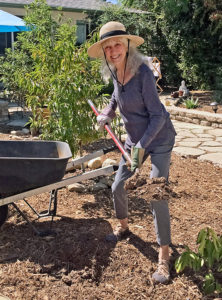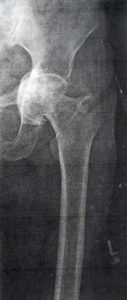Hip Moves by Lora – 10/15/2018

Hip Replacement Successful!
Hip Hip Hooray for Lora! She had a hip replacement in August 2018 and is shouting Hooray! because it was a total success.
How is it possible that she was hiking in minimal shoes all over Portugal with a backpack just last April? And how is it that she has maintained an active lifestyle hiking, gardening, squatting, hanging, and moving residences over the past five years? And why did a hip replacement suddenly become necessary? Here is her story in her own words.
Lora’s Story
Many of us who hang out in our hips a lot end up with hip replacements. I carried my kids mainly on my left hip so I could use my dominant right hand for work. Frequently I used that same hip for supporting most of my weight while standing. Fortunately, I never experienced significant pain in my hips. Instead, I developed a frozen knee.
In 2009, I was referred to Katy Bowman by a friend. Katy pointed out that knees and hips are connected. She got me started in basic stance alignment and restorative exercises including the pelvic list* for hip strengthening. I developed a regular practice of aligned movement. The frozen knee disappeared and my hips got stronger. I continued to follow my passions for movement including skiing.
Skiing Accident
In 2013 I joined my sister and brother-in-law in Utah for some downhill powder skiing. I had tightened my skis so they wouldn’t come off. And they didn’t when I fell into a snowbank and lay there for hours with a severely torqued left leg. Finally I was discovered and rescued. At the time, I felt some discomfort in my hip but it was not significant enough to seek medical attention.

In July 2018 my hip began to bother me. I had x-rays taken and could not believe what was revealed. This pre-op x-ray shows the head of my femur protruding through its socket (acetabulum) and into my pelvis. As I sat discussing the x-ray with the doctor, he said my hip could break at any minute just sitting there. Although the pain was not enormous, the pelvic invasion was, which made the surgery decision easy. Not so easy was finding the right surgeon and surgical method.
Surgery Method

Stem cells were a consideration; however, I learned they were not quite ready for what I needed. I found Dr. Andrew Yun at Providence St. Johns Hospital in Santa Monica, California. He has an awesome reputation and in my opinion he deserves it. He used a “frontal” approach with no muscle or vessel cutting. In the operating room, he cut off the head of the old femur and made a “body paste” with the bone. This paste was packed into the cleaned-up acetabulum which cradles the new head. This enhances and reinforces the acetabulum, and does away with the possibility of non-acceptance of the new material now part of my body.
Mobility Restored

Dr. Yun’s aftercare recommended a daily walk of 30 minutes, which appeals to a Katy Bowman student. He sees walking as the number one important recovery exercise. Three weeks post op, I was walking (cane optional) and finding no barriers to my usual activities other than my hikes were on mostly flat ground. I see the x-ray of my new hip as a work of art. Its placement takes into account all the pressures to which hips are subjected. Leg length has been bilaterally measured from the bottom of the pelvis. The head of the femur is in an optimal position for weight-bearing. Post-op pain was less than pre-op hip pain, so even at just three weeks I felt quite fortunate that the surgery was available for me.
Oh I almost forgot: post-operative patients usually go home the day after surgery. The day after I was able to walk, including up and down stairs, which was my ticket out! So if you don’t like the food or can’t sleep well in a hospital consider this approach. I do not downplay the trauma of a hip replacement. Out of respect for what my body has experienced, I’m eating, resting and exercising with awareness of and gratitude for my overall well-being. I attribute my excellent recovery to maintaining my practice of restorative exercises, particularly the pelvic list.
Strengthen Your Hips
*Blog by Katy Bowman about hip replacements and the pelvic list.
Drawings and instructions for the Pelvic List from our book, Dynamic Aging, pp. 210-211:

Instructions:
- From aligned stance, place your right hand on your right hip and, using the muscles on the outside of the right hip, bring the right side of your pelvis down toward the floor (which will result in your left foot lifting away from the ground).
- If your left foot doesn’t clear the ground, that’s okay; keep practicing engaging these muscles until it does.
- Check to make sure you’re not bending either knee, nor using the lower back of the floating side to lift the pelvis.

I love the ending, Joan. You’re a great editor. And having the exrays in makes it very clear, I think. Thanks for making my story blog-worthy.
Thank you for sharing your story! I never knew of the horrible skiing accident, and am so grateful your outcome is so wonderful! Yea! I have two questions for you, if you care to comment.
What is a frozen knee?
I have never felt like I could truly list. Like I do it but don’t think I really get any movement that isn’t cheating with my back muscles. It is my least favorite corrective and is impacted by my bow leggedness and externally rotated femurs, naturally. I do the side lying leg lifts, monster walk, and lots of knee correctives because of my knee problems. Are there any other listing tricks or other treatments you have discovered?
Thanks!
Lora is just amazing!
Hip Hip Lora, hooray!
xo xo
You, dear Lora, are an inspiration. I started to write that you are amazing. But really you are simply fulfilling the potential that we all have to fully appreciation and take astute care of our bodies. We are all capable of living life well in our body and we should aspire to follow your example.